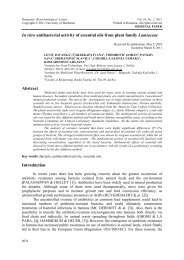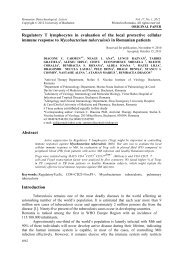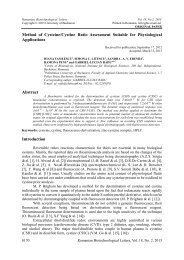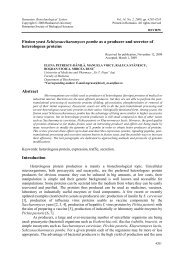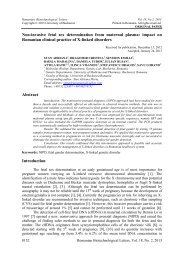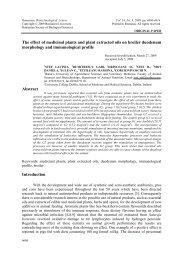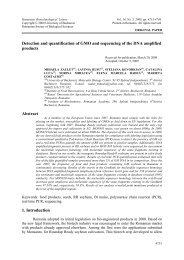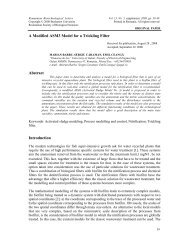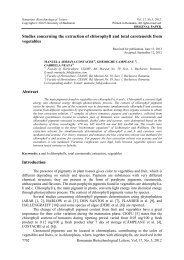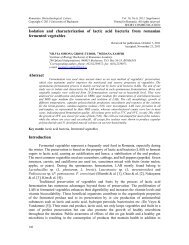TLC Applications on separation and quantification of fat - Romanian ...
TLC Applications on separation and quantification of fat - Romanian ...
TLC Applications on separation and quantification of fat - Romanian ...
Create successful ePaper yourself
Turn your PDF publications into a flip-book with our unique Google optimized e-Paper software.
<strong>Romanian</strong> Biotechnological Letters Vol. 14, No. 5, 2009, pp. 4615-4619<br />
Copyright © 2009 University <strong>of</strong> Bucharest Printed in Romania. All rights reserved<br />
<strong>Romanian</strong> Society <strong>of</strong> Biological Sciences<br />
REVIEW<br />
<str<strong>on</strong>g>TLC</str<strong>on</strong>g> <str<strong>on</strong>g>Applicati<strong>on</strong>s</str<strong>on</strong>g> <strong>on</strong> separati<strong>on</strong> <strong>and</strong> quantificati<strong>on</strong> <strong>of</strong> <strong>fat</strong>-soluble vitamins<br />
Abstract<br />
Received for publicati<strong>on</strong>, April 15, 2009<br />
Accepted, September 1, 2009<br />
ANA – MARIA HOSSU a , MIHAELA – FLORY MARIA b , CRISTIANA RADULESCU a ,<br />
MIHAELA ILIE c , VASILE MAGEARU d<br />
a<br />
Department <strong>of</strong> Chemistry, “Valahia” University <strong>of</strong> Targoviste, 18-22 Unirii Blvd.,<br />
Targoviste, Romania, e-mail: anahossu@yahoo.co.uk<br />
b<br />
Authority <strong>of</strong> Public Health Dambovita, 17-19 Tudor Vladimirescu Street, Targoviste,<br />
Romania<br />
c<br />
“Carol Davila” University <strong>of</strong> Medicine <strong>and</strong> Pharmacy, Faculty <strong>of</strong> Pharmacy, Toxicology<br />
Dept., 6 Traian Vuia Str., Bucharest, Romania<br />
d<br />
University <strong>of</strong> Bucharest, Faculty <strong>of</strong> Chemistry, Department <strong>of</strong> Analytical Chemistry, Sos.<br />
P<strong>and</strong>uri, No. 90, 76229, Sector 5, Bucharest, Romania<br />
The history <strong>of</strong> vitamins, <strong>on</strong>e <strong>of</strong> the most important chapters in the history <strong>of</strong> Biochemistry, had<br />
a pr<strong>of</strong>ound impact <strong>on</strong> health <strong>and</strong> wellbeing, as well as <strong>on</strong> underst<strong>and</strong>ing the catalytic processes<br />
acting in the metabolism <strong>of</strong> living organisms. Since antiquity it has been known that there is a direct<br />
relati<strong>on</strong> between illness <strong>and</strong> nourishment. A great number <strong>of</strong> methods have been developed to<br />
determine the c<strong>on</strong>tent <strong>of</strong> <strong>fat</strong>-soluble vitamins in pharmaceutical products.<br />
Though much less accurate than the other methods recommended in m<strong>on</strong>ographs, the thinlayer<br />
chromatography – <str<strong>on</strong>g>TLC</str<strong>on</strong>g> – finds its well deserved place am<strong>on</strong>g the analysis methods, when the<br />
relatively costly equipments involved by other methods are not available.<br />
Keywords: <strong>fat</strong>-soluble vitamins, thin-layer chromatography, pharmaceuticals.<br />
Introducti<strong>on</strong><br />
<str<strong>on</strong>g>TLC</str<strong>on</strong>g> is the most used method, it is applied to separate the comp<strong>on</strong>ents <strong>of</strong> a sample<br />
mixture by using the whole range <strong>of</strong> fundamental processes in chromatography: adsorpti<strong>on</strong>,<br />
distributi<strong>on</strong>, exclusi<strong>on</strong> – diffusi<strong>on</strong> <strong>and</strong> i<strong>on</strong> exchange. [1]<br />
A great part <strong>of</strong> the <strong>fat</strong>-soluble vitamins present in pharmaceutical or natural products is<br />
accompanied by a significant number <strong>of</strong> kindred compounds. This explains why the<br />
chromatographic methods are frequently used in the analysis <strong>of</strong> these compounds. <str<strong>on</strong>g>TLC</str<strong>on</strong>g> is an<br />
ideal method for them, as it is a simple, selective <strong>and</strong> sensitive method. [2]<br />
Results <strong>and</strong> discussi<strong>on</strong><br />
Specialized literature menti<strong>on</strong>s various methods for identifying <strong>and</strong> dosing <strong>of</strong> vitamin<br />
A, both from pharmaceutical products <strong>and</strong> from biologic fluids. The European Pharmacopoeia<br />
[3] menti<strong>on</strong>s 2 methods for identifying <strong>of</strong> vitamin A in various pharmaceutical products by<br />
using <str<strong>on</strong>g>TLC</str<strong>on</strong>g>, namely:<br />
- by using Silica Gel F254 plates; prepare a soluti<strong>on</strong> c<strong>on</strong>taining approximately 3.3 U.I. <strong>of</strong><br />
vitamin A/µL in cyclohexane, stabilized with 1 g/L soluti<strong>on</strong> <strong>of</strong> butyl hidroxytoluene; the<br />
reference soluti<strong>on</strong> c<strong>on</strong>tains approximately 0.01 mg retinol/µL ester (3.3 U.I. from each<br />
4615
4616<br />
ANA – MARIA HOSSU, MIHAELA – FLORY MARIA, CRISTIANA RADULESCU, MIHAELA ILIE,<br />
VASILE MAGEARU<br />
ester/µL) in cyclohexane, stabilized with 1 g/L soluti<strong>on</strong> <strong>of</strong> butyl hidroxytoluene; 3 µL <strong>of</strong> each<br />
soluti<strong>on</strong> is spotted <strong>on</strong> the plate;<br />
- for synthetic oily vitamin A c<strong>on</strong>centrates prepared from synthetic retinol ester, the<br />
identificati<strong>on</strong> is performed by means <strong>of</strong> thin layer chromatography (<str<strong>on</strong>g>TLC</str<strong>on</strong>g>) using Silica Gel<br />
F254 plates with cyclohexane soluti<strong>on</strong>, stabilized with 1 g/L soluti<strong>on</strong> <strong>of</strong> butyl hidroxytoluene;<br />
the ultraviolet examinati<strong>on</strong> is made at 254 nm.<br />
For vitamin D, the European Pharmacopoeia indicates the thin layer chromatography<br />
(<str<strong>on</strong>g>TLC</str<strong>on</strong>g>) using Silica Gel G plates as identificati<strong>on</strong> method from various pharmaceutical<br />
products; prepare a soluti<strong>on</strong> c<strong>on</strong>taining 0.25 g substance in ethylene chlorine; prepare<br />
reference soluti<strong>on</strong>s as well; spot 10 µL <strong>of</strong> each soluti<strong>on</strong> <strong>on</strong> the plate.<br />
For vitamin E, the European Pharmacopoeia indicates the thin layer chromatography<br />
(<str<strong>on</strong>g>TLC</str<strong>on</strong>g>) using Silica Gel HF254R plates as identificati<strong>on</strong> method from various pharmaceutical<br />
products; prepare a soluti<strong>on</strong> c<strong>on</strong>taining 10 mg substance in cyclohexane; prepare reference<br />
soluti<strong>on</strong>s as well; spot 10 µL <strong>of</strong> each soluti<strong>on</strong> <strong>on</strong> the plate.<br />
In thin layer chromatography, vitamins A, D <strong>and</strong> E, as well as their provitamins <strong>and</strong><br />
esters are easily influenced by the envir<strong>on</strong>ment c<strong>on</strong>diti<strong>on</strong>s; the risk <strong>of</strong> their degradati<strong>on</strong>, even<br />
destructi<strong>on</strong>, by oxidati<strong>on</strong> was enhanced by their l<strong>on</strong>g-term exposure to air <strong>on</strong> wide surfaces.<br />
These phenomena were minimized by working in darkness, under nitrogen flow, at 0 0 C. [4]<br />
The absorpti<strong>on</strong> thin layer chromatography was highly used within studies <strong>on</strong> vitamins<br />
D, the most frequently used adsorbent being silica. This material has a high adsorpti<strong>on</strong><br />
capacity <strong>and</strong> allows for fine <strong>and</strong> quick separati<strong>on</strong>s <strong>of</strong> important quantities <strong>of</strong> analytes, without<br />
plate overload. Janecke <strong>and</strong> Maass-Goebels [5] were the first to achieve separati<strong>on</strong>s through<br />
adsorpti<strong>on</strong> <str<strong>on</strong>g>TLC</str<strong>on</strong>g> <strong>of</strong> vitamins D mixtures. They succeeded in separating these vitamins from<br />
various sterols, from degradati<strong>on</strong> products <strong>and</strong> from carotenes, using Silica Gel G plates <strong>and</strong><br />
various mobile phases: hexane, hexane/ethyl acetate (90/10 v/v) <strong>and</strong> chlor<strong>of</strong>orm. As a<br />
c<strong>on</strong>sequence, the normal-phase absorpti<strong>on</strong> thin layer chromatography was used within<br />
separati<strong>on</strong>s <strong>of</strong> mixtures c<strong>on</strong>taining <strong>fat</strong>-soluble vitamins (Table 1) [4-9].<br />
Table 1. <str<strong>on</strong>g>Applicati<strong>on</strong>s</str<strong>on</strong>g> <strong>of</strong> normal-phase <str<strong>on</strong>g>TLC</str<strong>on</strong>g> in the separati<strong>on</strong> <strong>of</strong> complex mixtures c<strong>on</strong>taining liposoluble<br />
vitamins<br />
Sample compositi<strong>on</strong><br />
Chromatographic systems:<br />
Stati<strong>on</strong>ary phase<br />
Mobile phase<br />
Lipid extracts c<strong>on</strong>taining cholesterol, vitamin A<br />
Silica Gel<br />
esters, α-tocopherol acetate <strong>and</strong> vitamin D [4] Cyclohexane/diethyl ether (1/1 v/v)<br />
Fat-soluble vitamins, carotenes, quin<strong>on</strong>es <strong>and</strong><br />
Silica Gel<br />
chlorophyll [5]<br />
- Cyclohexane/diethyl ether (1/1 v/v)<br />
- Chlor<strong>of</strong>orm, hexane/ethyl acetate (9/1<br />
v/v)<br />
- Cyclohexane/chlor<strong>of</strong>orm (6/4 v/v)<br />
- Benzene/methanole (98/2 v/v)<br />
Fat-soluble vitamins [6] Alumina<br />
14 individual solvents<br />
Best separati<strong>on</strong>s were obtained with:<br />
benzene, toluene, xylol <strong>and</strong> carb<strong>on</strong><br />
tetrachloride<br />
Vitamins A, D <strong>and</strong> E [7] Silica Gel<br />
Hexane/ethyl-methyl-ket<strong>on</strong>e/dibutyl<br />
Rom. Biotechnol. Lett., Vol. 14, No. 5, 4615-4619 (2009)
<str<strong>on</strong>g>TLC</str<strong>on</strong>g> <str<strong>on</strong>g>Applicati<strong>on</strong>s</str<strong>on</strong>g> <strong>on</strong> separati<strong>on</strong> <strong>and</strong> quantificati<strong>on</strong> <strong>of</strong> <strong>fat</strong>-soluble vitamins<br />
ether<br />
(34/7/6 v/v/v)<br />
Fat-soluble vitamins [8] Silica Gel <strong>and</strong> alumina<br />
13 solvents mixtures<br />
Vitamins A, D <strong>and</strong> antioxidants [9] Silica Gel impregnated with fluorescein<br />
Hexane/ethyl-methyl-ket<strong>on</strong>e/dibutyl<br />
ether<br />
(34/7/6 v/v/v)<br />
+ triethylamina<br />
These first surveys are the basis <strong>of</strong> the implementati<strong>on</strong> <strong>of</strong> this technique in the<br />
identificati<strong>on</strong> <strong>and</strong> measurement <strong>of</strong> vitamin D in more complex samples, especially in food<br />
matrices [10,11]. Adsorpti<strong>on</strong> <str<strong>on</strong>g>TLC</str<strong>on</strong>g> allowed equally for the study <strong>of</strong> safe isomerisati<strong>on</strong>s <strong>of</strong><br />
vitamins D. It also allowed for checking the hypothesis issued especially <strong>on</strong> the mechanism <strong>of</strong><br />
isomerisati<strong>on</strong> from provitamin D to vitamin D [12], from previtamin D to vitamin D <strong>and</strong><br />
reverse [4,13,14], <strong>and</strong> from tachisterol to isotachisterol [15-17] <strong>and</strong> for determining the<br />
kinetics <strong>of</strong> these c<strong>on</strong>versi<strong>on</strong>s. This technique was used for the separati<strong>on</strong> <strong>of</strong> vitamins D <strong>and</strong> <strong>of</strong><br />
their hydroxylate metabolites [18]. In the United States it has been for several years <strong>on</strong>e <strong>of</strong> the<br />
reference USP techniques for vitamins D2 <strong>and</strong> D3 identificati<strong>on</strong> tests [19]. It is also used to<br />
check the purity <strong>of</strong> vitamin D3 marked with radioactive isotopes [20].<br />
Molecules kindred with vitamins D groups (sterols, vitamin D esters, etc.) could be<br />
separated by the latter <strong>on</strong> Silica Gel impregnated with silver nitrate, the separati<strong>on</strong> depending<br />
<strong>on</strong> the number <strong>of</strong> double b<strong>on</strong>ds in molecules [21].<br />
The <str<strong>on</strong>g>TLC</str<strong>on</strong>g> analysis was used for vitamin D identificati<strong>on</strong> <strong>on</strong> Silica Gel in Complex<br />
Calcium III tablets, using as mobile phase cyclohexane-ether-benzene (8:4:1), detecti<strong>on</strong> by<br />
spraying with sulphuric acid-acetic anhydride-10% ethanol (1:1:8) <strong>and</strong> heating to 110 0 C for 5<br />
minutes [22].<br />
The analysis <strong>of</strong> a mixture including <strong>fat</strong>-soluble vitamins such as D1, D2 <strong>and</strong><br />
tocopherols was performed by using as mobile phase acet<strong>on</strong>e-c<strong>on</strong>centrated acetic acid (3:2),<br />
detecti<strong>on</strong> being made with a soluti<strong>on</strong> in chlor<strong>of</strong>orm <strong>of</strong> stibium chlorinate (III) [23].<br />
The <str<strong>on</strong>g>TLC</str<strong>on</strong>g> method was applied using Silica Gel, mobile phase hexane-ether (9:1) with<br />
traces <strong>of</strong> formic acid <strong>and</strong> quantificati<strong>on</strong> through densitometry at 350 nm for retinoic acid <strong>and</strong><br />
at 280 nm for vitamin E [24].<br />
HP<str<strong>on</strong>g>TLC</str<strong>on</strong>g> analysis <strong>of</strong> vitamin D3 was performed by using Silica Gel with cu hexane (5<br />
cm, without saturati<strong>on</strong> chamber) <strong>and</strong> after intermediary drying with cyclohexane/diethyl ether<br />
1:1 (7 cm, in saturated chamber with solvent); chromatography in darkness far from UV light<br />
source; quantificati<strong>on</strong> through densitometry with absorbance at 268 nm [25].<br />
HP<str<strong>on</strong>g>TLC</str<strong>on</strong>g> analysis from the human plasma <strong>of</strong> plasma retinol, <strong>of</strong> α-tocopherol <strong>and</strong> <strong>of</strong><br />
tocopheryl acetate <strong>on</strong> Silica Gel was performed using as mobile phase chlor<strong>of</strong>ormcyclohexane<br />
(55:45), quantificati<strong>on</strong> through densitometry at 290 nm, detecti<strong>on</strong> limits 160<br />
ng/mL for vitamin A <strong>and</strong> 1.2 µg/mL for vitamin E [26].<br />
Analysis <strong>of</strong> 14 isolated substances, characterised by their spectral properties,<br />
degradati<strong>on</strong> products resulted from β-carotene <strong>and</strong> retinyl acetate was performed using as<br />
mobile phase hexane/ether (9:1) [27].<br />
For derivates <strong>of</strong> vitamin A, <str<strong>on</strong>g>TLC</str<strong>on</strong>g> was applied using Silica Gel RP-2 <strong>and</strong> Silica Gel<br />
impregnated with 10% paraffin in cyclohexane, mobile phase methanol/water (19:1) [28].<br />
Rom. Biotechnol. Lett., Vol. 14, No. 5, 4615-4619 (2009) 4617
ANA – MARIA HOSSU, MIHAELA – FLORY MARIA, CRISTIANA RADULESCU, MIHAELA ILIE,<br />
VASILE MAGEARU<br />
<str<strong>on</strong>g>TLC</str<strong>on</strong>g> analysis was applied for identificati<strong>on</strong> <strong>of</strong> vitamin E with Silica Gel plates, using<br />
as mobile phase petroleum ether (60-90 o C)/ethyl acetate (95:5), quantificati<strong>on</strong> through<br />
densitometry at 280 nm [29].<br />
13 stati<strong>on</strong>ary phase – mobile phase systems were investigated for separating <strong>and</strong><br />
identifying vitamins A, D <strong>and</strong> E from pharmaceutical products (vitamin A+D2 s<strong>of</strong>t gelatinous<br />
capsules, vitamin A soluti<strong>on</strong>, vitamin E s<strong>of</strong>t gelatinous capsules <strong>and</strong> fish oil s<strong>of</strong>t gelatinous capsules)<br />
[30].<br />
The systems providing the best results were: stati<strong>on</strong>ary phase Silica Gel 60 F254 <strong>on</strong><br />
plastic foil from Merck <strong>and</strong> hexane/ether (9:1, v:v) or benzene/chlor<strong>of</strong>orm (1:1, v:v) as<br />
mobile phase, which were photo documented in UV at 254 nm <strong>and</strong> for which we found values<br />
Rf <strong>of</strong> 0.463 for vitamin A acetate <strong>and</strong> 0.065 for D2, respectively 0.186 for D2 <strong>and</strong> 0.703 for αtocopherol<br />
acetate.<br />
Semi-quantitative analysis <strong>of</strong> vitamins, performed based <strong>on</strong> the blacking-out curves <strong>of</strong><br />
the corresp<strong>on</strong>ding spot as spotted substance mass functi<strong>on</strong> led to a sec<strong>on</strong>d degree multinomial<br />
functi<strong>on</strong> (correlati<strong>on</strong> coefficient R = 1, p = 0.0159) for vitamin A acetate <strong>and</strong> to regressi<strong>on</strong><br />
lines for vitamins D2 <strong>and</strong> E acetate (correlati<strong>on</strong> coefficient R = 0.98994, p = 0.01006,<br />
respectively R = 0.98191, p = 0.01809).<br />
The results obtained allow for easy implementati<strong>on</strong> <strong>of</strong> <str<strong>on</strong>g>TLC</str<strong>on</strong>g> method in an analysis<br />
laboratory.<br />
C<strong>on</strong>clusi<strong>on</strong>s<br />
The <str<strong>on</strong>g>TLC</str<strong>on</strong>g> identificati<strong>on</strong> <strong>and</strong> semi-quantitative dosage methods are generally robust;<br />
they need a minimum <strong>of</strong> equipments <strong>and</strong> reactive, <strong>and</strong> can be easily adapted in small analysis<br />
laboratories.<br />
The <str<strong>on</strong>g>TLC</str<strong>on</strong>g> methods are easy to apply, do not take l<strong>on</strong>g sample preparati<strong>on</strong> time <strong>and</strong> do<br />
not lead to interferences in case <strong>of</strong> pharmaceutical products c<strong>on</strong>taining low numbers <strong>of</strong><br />
vitamins, such as vitamin A+D2 s<strong>of</strong>t gelatinous capsules, vitamin A soluti<strong>on</strong> <strong>and</strong> vitamin E<br />
s<strong>of</strong>t gelatinous capsules; they are more difficult to apply <strong>and</strong> interpret when used <strong>on</strong> more<br />
complex mixtures, such as fish oil s<strong>of</strong>t gelatinous capsules.<br />
References<br />
1. S. BUNGĂU, V. MERCA, L. COPOLOVICI, Analiză instrumentală şi metode de separare, Ed. Universităţii<br />
din Oradea, 2004.<br />
2. FUNK, J., FISCHER, W., THIN-LAYER Chromatography. Reagents <strong>and</strong> Detecti<strong>on</strong> Methods – VCH<br />
Verlagsgesellschaft mbH, Weinheim, 1990.<br />
3. *** European Pharmacopoeia 4-th editi<strong>on</strong> 2003.<br />
4. H.R. BOLLIGER, A. KÖNING, The D vitamins in Thin Layer Chromatography (2nd edn, E. Stahl ed.,<br />
Springer-Verlag, Berlin-Heidelberg-New York), 275, 1969.<br />
5. H. JANECKE, L. MAASS-GOEBELS, Z. Anal. Chem., 178, 161, 1960.<br />
6. J. DAVIDEK, J. BLATTNA, J. Chromatogr., 7, 204, 1962.<br />
7. R. STROHECKER, H.M. HENNING, Vitamin Assay-Tested Method (Verlag Chemie, Weiheim), 275, 1966.<br />
8. M.H. HASHMI, F.R. CHUGHTAI, S.A. ADIL, T. QURESHI, Mikrochim. Acta, III, 1967.<br />
9. F.C. JOHNSON, C. VICKERS, Analyst, 98, 257, 1973.<br />
10. F. BEKES, E. BERNDORFER-KRASZNER, R. LASZTITY, F. ORSI, I. DOBOS, Nahrung, 21, 27, 1977.<br />
11. P. CZUCZY, E. MORAVA, Anal. Chem. Symp. Ser., 483, 1982.<br />
12. A.W. NORMAN, H.F. DE LUCA, Anal. Chem., 35, 1247, 1963.<br />
13. K.H. HANEWALD, F.J. MULDER, K.J. KEUNING, J. Pharm. Sci., 57, 1308, 1968.<br />
4618<br />
Rom. Biotechnol. Lett., Vol. 14, No. 5, 4615-4619 (2009)
<str<strong>on</strong>g>TLC</str<strong>on</strong>g> <str<strong>on</strong>g>Applicati<strong>on</strong>s</str<strong>on</strong>g> <strong>on</strong> separati<strong>on</strong> <strong>and</strong> quantificati<strong>on</strong> <strong>of</strong> <strong>fat</strong>-soluble vitamins<br />
14. G. PONCHON, F.X. FELLERS, J. Chromatogr., 57, 1308, 1968.<br />
15. T. KOBAYASHI,<br />
a. Vitamins, 34, 473, 1966.<br />
b. J. Vitaminol., 13, 255, 1967.<br />
c. Ibid., 13, 258, 1967.<br />
d. Ibid., 13, 265, 1967.<br />
16. T. KOBAYASHI, A. ADACHI, J. Nutr. Sci. Vitaminol., 19, 311, 1973.<br />
17. T. KOBAYASHI, A. ADACHI, J. Nutr. Sci. Vitaminol., 19, 303, 1973.<br />
18. G. JONES, D.A. SEAMARK, D.J.H. TRAFFORD, H.L.J. MAKIN, Modern Chromatographic Analysis <strong>of</strong><br />
Vitamins (2nd editi<strong>on</strong>, A.P. De Luyner, W.E. Lambert & J. Nelis eds, Chromatographic Sciences Series), 60, 73,<br />
1992.<br />
19. Cholecalciferol & Ergocalciferol in United States Pharmacopoeia (20th edn., Mack Printing, East<strong>on</strong> PE),<br />
147 şi 282, 1980.<br />
20. Product Specificati<strong>on</strong>s Literature (New Engl<strong>and</strong> Nuclear, Bost<strong>on</strong> MA & Amersham Corporati<strong>on</strong>, Arlingt<strong>on</strong><br />
Height IL) 1978.<br />
21. a) J.W. PEEREMBOOM, H.W. BEEKES, J. Chromatogr., 17, 99, 1965.<br />
b) C.K. PAREKH, R.H. WASSERMAN, Ibid., 17, 261, 1965.<br />
c) D. SKLAN, P. BUDOWSKI, Anal. Chem., 49, 200, 1973.<br />
22. W. ZHONG, Y. ZHAO, Chinese J. Hosp. Pharm., 21(3), 187-188, 2001.<br />
23. N. PERISIC-JANJIC, B. VUJICIC, J. Planar Chromatogr., 10, 447-452, 1997.<br />
24. G. LI, ZH. ZHUANG, R. ZHOU, X. SHI, Chinese J. Hosp. Pharm., 15, 162-162, 1995.<br />
25. B. DAS, J. Planar Chromatogr., 7, 162-164, 1994.<br />
26. J.D. CHAVAN, J.M. KHATRI, J. Planar Chromatogr., 5, 280-282, 1992.<br />
27. M. HOLASOVA, H. PARIZKOVA, J. BLATTNA, Proc. Of Euro Food Chem. III, Vol. 2, 101-106,<br />
Antwerp, Belgium, 1985.<br />
28. J. SLIWIOK, A. PODGORNY, A. SIWEK, B. WITKOWSKA, J. Planar Chromatogr., 3, 429-430, 1990.<br />
29. M. BAI, M. LIN, R. BAI, Chinese J. Herb. Med., 24, 652-653, 1993.<br />
30. A.-M. HOSSU, C. RĂDULESCU, M. ILIE, D. BĂLĂLĂU, V. MAGEARU, Revista de Chimie, 57(11),<br />
1188-1189, 2006.<br />
Rom. Biotechnol. Lett., Vol. 14, No. 5, 4615-4619 (2009) 4619



